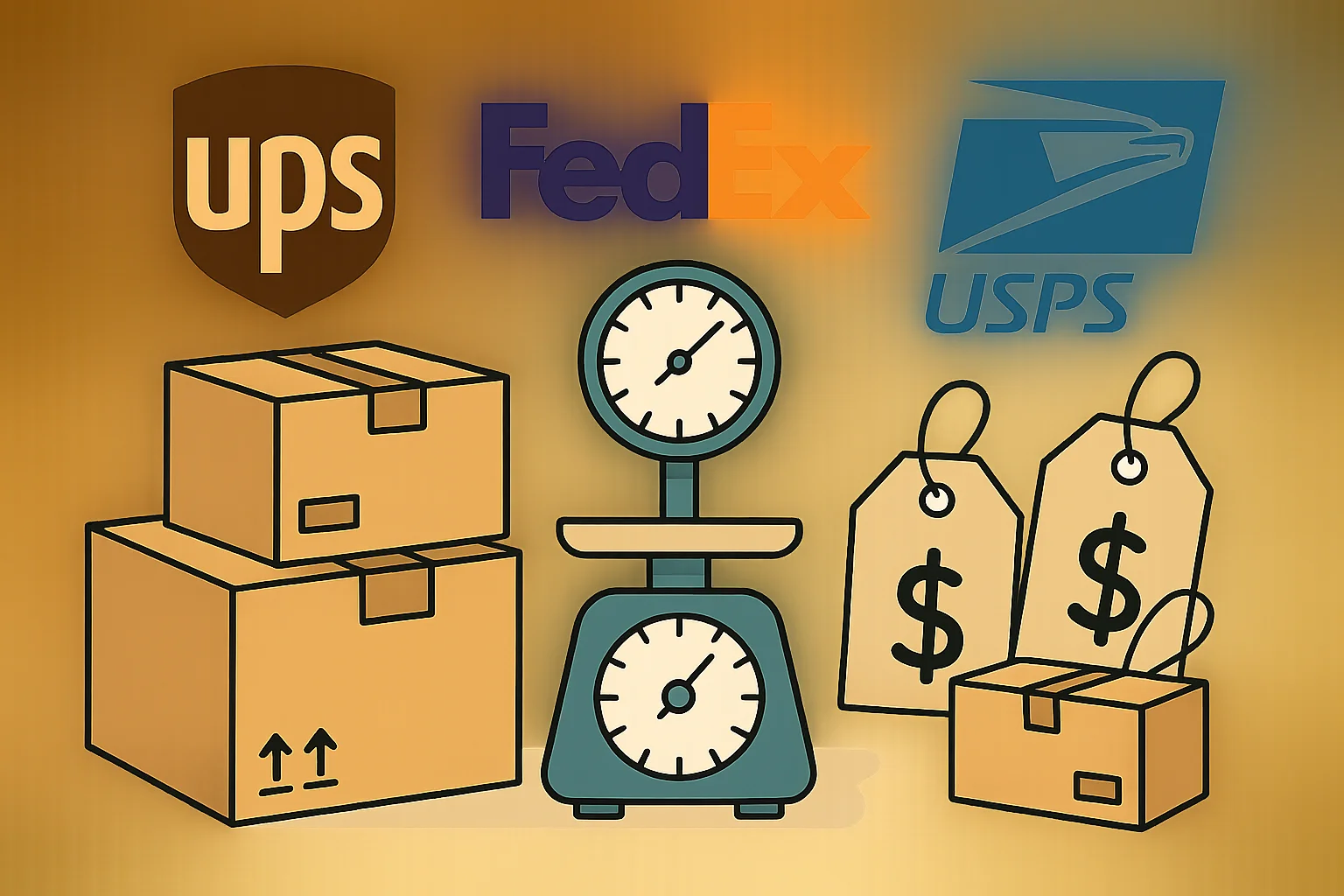Shipping heavier packages between 20-50 pounds presents unique challenges and costs that can significantly impact both businesses and individual shippers. Understanding the various factors that influence shipping costs, comparing carrier options, and implementing cost-saving strategies is essential for making informed shipping decisions.
Cost Overview: What to Expect
The cost to ship a 20-pound package typically ranges from $16 to $335, while a 50-pound package generally costs between $25 and $555, depending on the carrier, service level, distance, and additional factors. Ground shipping represents the most economical option, with UPS Ground and FedEx Ground offering the lowest rates for both weight categories.
Key Cost Ranges by Weight:
- 20 lb packages: $16-$335 depending on service and distance
- 50 lb packages: $25-$555 with similar service variations
Detailed Carrier Comparison
Ground Shipping Services (Most Economical)
UPS Ground emerges as the most cost-effective option for heavy packages, with 20-pound shipments costing $16.10-$166.06 and 50-pound packages ranging from $24.73-$316.11. This service typically delivers within 1-5 business days and offers excellent value for non-urgent shipments.
FedEx Ground provides competitive rates, particularly for 20-pound packages ($16.21-$36.17), though 50-pound shipments can cost $30.90-$374.75. FedEx Ground often represents the cheapest option for lighter packages within the 20-50 pound range.
USPS Ground Advantage offers rates of $22.20-$68.60 for 20-pound packages and starts at $92.40 for 50-pound shipments. While not always the cheapest, USPS provides good value with delivery in 2-5 business days.
Express Shipping Services
For expedited delivery, costs increase substantially. UPS 2nd Day Air ranges from $44.45-$185.36 for 20-pound packages and $86.21-$370.88 for 50-pound shipments. FedEx 2Day offers similar pricing at $47.62-$176.30 for 20 pounds and approximately $70-$400+ for 50 pounds.
Overnight services command premium prices, with UPS Next Day Air costing $71.67-$334.89 for 20 pounds and $131.19-$553.61 for 50 pounds. USPS Priority Mail Express represents the most expensive option at $374.75+ for 50-pound packages.
Critical Cost Factors to Consider
Dimensional Weight (DIM) Pricing
One of the most significant factors affecting shipping costs is dimensional weight pricing, which can increase costs by 2-3 times for large, lightweight packages. Carriers calculate DIM weight using the formula (Length × Width × Height) ÷ DIM Factor, where UPS uses 166 for retail rates and 139 for daily rates, while FedEx uses 139.
For packages where the dimensional weight exceeds the actual weight, shippers pay based on the higher calculation. This particularly impacts bulky but light items, making proper packaging crucial for cost control.
Distance and Shipping Zones
Shipping costs increase significantly with distance, typically rising 20-30% with each additional zone. The continental United States is divided into shipping zones, with Zone 1 representing local deliveries and Zone 8 covering cross-country shipments. A package that costs $5 to ship locally (Zone 1) might cost $15 or more when shipped to Zone 8.
Additional Surcharges and Fees
Fuel Surcharges currently add 15-20% to base shipping costs and are updated weekly based on fuel price fluctuations. For example, a $25 base shipping cost with an 18% fuel surcharge would add $4.50 to the total.
Residential Delivery Surcharges add $3.70 (UPS) to $6.20 (FedEx) to shipments delivered to homes rather than businesses. Rural and remote area deliveries incur additional $5-15 surcharges depending on location.
Other Common Fees:
- Signature required services: $3-8 additional
- Saturday delivery: $16-20 surcharge
- Large package surcharges for oversized items
- Additional handling fees for irregular packages
2025 Rate Increases
Major carriers have implemented significant rate increases for 2025. UPS and FedEx increased rates by an average of 5.9% effective December 2024 and January 2025 respectively. USPS implemented varied increases ranging from 3.2% for Priority Mail to 9.2% for Parcel Select services.
USPS Flat Rate Options
For heavy packages, USPS Flat Rate boxes can provide excellent value, allowing shipments up to 70 pounds for a fixed price regardless of distance. Current flat rate pricing includes:
- Small Flat Rate Box: $9.25 (commercial) / $11.70 (retail)
- Medium Flat Rate Box: $17.50 (commercial) / $21.05 (retail)
- Large Flat Rate Box: $24.30 (commercial) / $29.95 (retail)
These options work best for heavy, dense items that fit within the box dimensions and are traveling long distances.
Insurance and Protection Options
Shipping insurance becomes increasingly important for heavier, more valuable packages. Basic coverage varies by carrier, with USPS Priority Mail including $100 of insurance. Additional coverage typically costs 1.25-3% of the declared value.
Third-party insurance providers often offer more comprehensive coverage at competitive rates, sometimes providing better claim processing and broader protection than carrier-provided insurance.
Cost-Saving Strategies
Packaging Optimization
Right-sizing packages is crucial for controlling dimensional weight charges. Using appropriately sized boxes minimizes wasted space and reduces DIM weight calculations. Consolidating multiple items into single shipments when possible also reduces per-item shipping costs.
Multi-Carrier Strategy
Comparing rates across multiple carriers for each shipment can yield significant savings. Ground services typically offer the best value for non-urgent deliveries, while regional carriers may provide competitive rates for specific routes.
Regional carriers like OnTrac, LaserShip, and Spee-Dee often offer rates 20-40% lower than national carriers within their service areas. These carriers excel at short-distance deliveries and can provide faster service than national carriers for regional shipments.
Volume Discounts and Negotiations
Businesses shipping regularly should negotiate rates with carriers based on volume commitments. Even small businesses can often secure 5-15% discounts through consistent shipping patterns and volume negotiations.
Strategic Timing and Planning
Avoiding peak season surcharges during holidays can save substantial money. Planning shipments during off-peak periods and consolidating orders to meet free shipping thresholds also reduces costs.
Special Considerations for Heavy Packages
Weight Restrictions and Additional Handling
Packages over 70 pounds may require special handling and incur additional fees. UPS requires bright yellow “heavy package” stickers for items over 70 pounds, though their standard service handles packages up to 150 pounds.
Breaking Down Large Shipments
For extremely heavy shipments (over 150 pounds), consider breaking them into multiple smaller packages. Some shippers report that sending multiple 20-pound packages can be more cost-effective than one heavy shipment due to USPS pricing structures that dramatically increase after 20 pounds.
Conclusion
Shipping 20-50 pound packages requires careful consideration of multiple factors including carrier choice, service level, packaging optimization, and additional surcharges. Ground services typically offer the best value, with UPS Ground and FedEx Ground providing the most economical options for most routes. However, factors like dimensional weight, distance, residential delivery, and fuel surcharges can significantly impact final costs.
By understanding these variables and implementing strategic approaches such as right-sizing packages, comparing carriers, negotiating volume discounts, and utilizing regional carriers when appropriate, shippers can achieve substantial cost savings while maintaining reliable service. The key is to evaluate each shipment individually, considering the total cost of ownership including potential insurance, handling fees, and delivery requirements.
As shipping rates continue to increase annually, staying informed about carrier changes and maintaining flexibility in shipping strategies becomes increasingly important for managing logistics costs effectively. Whether shipping occasionally or operating a high-volume business, the principles outlined in this guide provide a foundation for making cost-effective shipping decisions in the heavy package category.



Leave a Reply